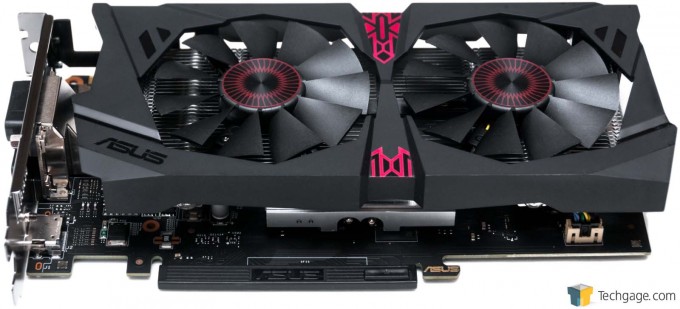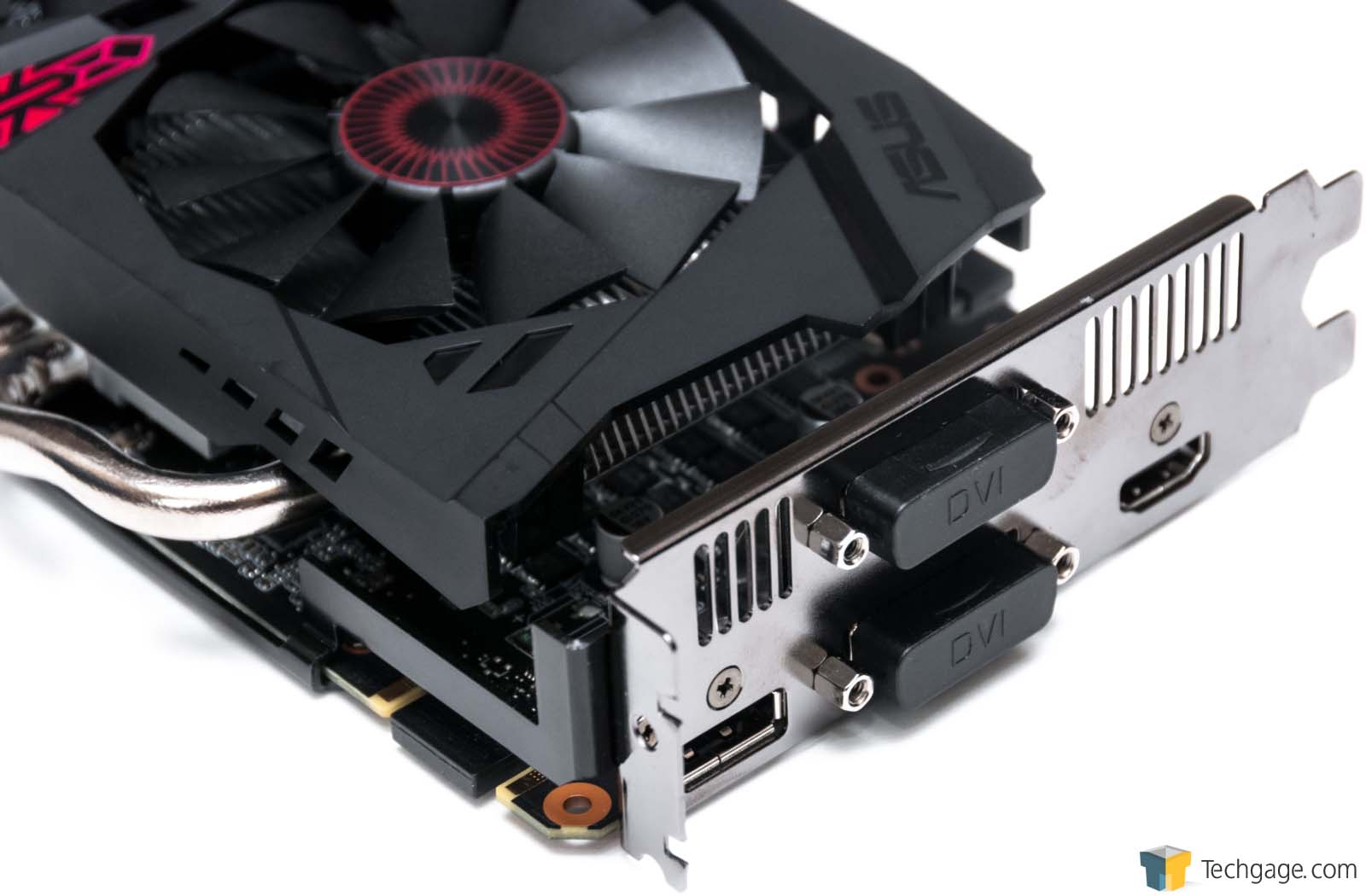- Qualcomm Launches Snapdragon 4 Gen 2 Mobile Platform
- AMD Launches Ryzen PRO 7000 Series Mobile & Desktop Platform
- Intel Launches Sleek Single-Slot Arc Pro A60 Workstation Graphics Card
- NVIDIA Announces Latest Ada Lovelace Additions: GeForce RTX 4060 Ti & RTX 4060
- Maxon Redshift With AMD Radeon GPU Rendering Support Now Available
ASUS GeForce GTX 950 STRIX Graphics Card Review

NVIDIA rounds out the entry-level part of its Maxwell-based lineup with the GeForce GTX 950. As a successor to the GTX 750 Ti, the GTX 950 boosts performance significantly while draining just a wee bit more power. And as we’ll see, the ASUS STRIX model offers its own set of perks, including possible 0dB operation.
Page 1 – Introduction
Some 18 months after the launch of the first-gen Maxwell card, GeForce GTX 750 Ti, we’re introduced to its successor: GeForce GTX 950. While the GTX 750 Ti impressed us with its ability to deliver solid 1080p game performance without the use of a power connector, the GTX 950’s much-improved performance couldn’t afford the same design. A bummer, but one that the card manages to make up for.
As has become a theme with mid-range and lower parts, NVIDIA is touting its GTX 950 as being an ideal choice for MOBA gamers who demand excellent performance and don’t want to break the bank. Fortunately, that latter goal isn’t too hard to pull off thanks to the very nature of most MOBA games – they’re isometric, limit what you can see, don’t usually strive for realism, and thus run quite well even on older cards.
With its GTX 950 launch, though, NVIDIA wants to draw attention to the fact that a card like this one could dramatically reduce latency in MOBAs and other games. It’s not just about framerates, but also how quickly clicks will result in an action ingame. The video below explains the effect well.
httpv://www.youtube.com/watch?v=AZv1ZgDxBSY
For those who can’t view the video (or don’t want to), NVIDIA shows a click made with the GTX 650 taking 107ms to register the action on the screen, while the value drops to less than half for the GTX 950. While it’s obvious that a faster graphics card is going to deliver smoother and more timely frames, there’s more to it than that here.
NVIDIA’s GeForce Experience suite allows gamers to optimize their games with one click, and within that click can be many different ingame (sometimes even unofficial) settings that are tweaked. Coupled with this and the GTX 950’s architectural design, the graphics pipeline is more optimized to both increase performance and reduce latencies, ultimately giving us the result that NVIDIA shows off in the video.
Considering the article has just begun, there’s been a fair bit of MOBA talk. While NVIDIA’s targeting the genre with its GTX 950, that’s just because the card can act like a relative powerhouse when it comes to many of the titles found in it. Ultimately, the GTX 950 is designed to offer an excellent 1080p experience for the card’s $159 price point. Does it deliver? We’ll soon find out.
First, let’s take a look at the GTX 950 iteration that hit our doorstep: ASUS’ STRIX edition. It’s somewhat appropriate that this is the model we received as both the GTX 960 and GTX 970 we reviewed for launch were also STRIX cards.
This STRIX model looks similar to the others, and carries with it similar goals. At the forefront, that includes 3x quieter operation, and if loads are really light, 0dB operation. Further perks include 5-phase Super Alloy Power II, a fancy way of saying the card uses very high-quality components, and GPU Tweak II, a performance tweaker that bundles in Xsplit Gamecaster.
Before we go further, here’s a roundup of specs for NVIDIA’s latest GeForce series, along with the last-gen GTX 750 Ti as it’s in effect the predecessor to the GTX 950.
| NVIDIA GeForce Series | Cores | Core MHz | Memory | Mem MHz | Mem Bus | TDP |
| GeForce GTX TITAN X | 3072 | 1000 | 12288MB | 7000 | 384-bit | 250W |
| GeForce GTX 980 Ti | 2816 | 1000 | 6144MB | 7000 | 384-bit | 250W |
| GeForce GTX 980 | 2048 | 1126 | 4096MB | 7000 | 256-bit | 165W |
| GeForce GTX 970 | 1664 | 1050 | 4096MB | 7000 | 256-bit | 145W |
| GeForce GTX 960 | 1024 | 1126 | 2048MB | 7010 | 128-bit | 120W |
| GeForce GTX 950 | 768 | 1024 | 2048MB | 6600 | 128-bit | 90W |
| GeForce GTX 750 Ti | 640 | 1020 | 2048MB | 5400 | 128-bit | 60W |
Being built on the second-gen Maxwell architecture, the GTX 950 stands to be much better than the GTX 750 Ti even if the specs were kept exact. But to give things a further boost, we see an increase to the cores as well as to the memory speed. Both cards come equipped with a 128-bit memory bus.
As the lowest-end card to come out 11 months after the initial second-gen Maxwell cards, it’s not too hard to surmise what it will be capable of even before we get into testing. Once again, “excellent 1080p gaming”.
ASUS’ STRIX edition GTX 950 includes a total of four ports, including two DVI, a DisplayPort, and an HDMI port. In the first shot in the slide above, you can see that unlike the GTX 750 Ti, the GTX 950 supports SLI – a nice perk, especially if you are a MOBA gamer who wants to make the jump to the “sweet spot” 1440p resolution by simply buying a second card rather than a singular higher-end one.
STRIX emphasizes effective cooling, and shots above highlight that well. Looking at the card top-down, it’s easy to see that ASUS tried to give this card as much breathing-room as possible. It has two mammoth heatpipes coming out the top, and fins running along the entire surface. Also seen in these shots is the singular 6-pin power connector the card requires.
Remember how GPUs of this price point used to look? Yeah – I’m sure glad the times have changed that. This STRIX card looks great and will enhance any PC it’s installed into.
Support our efforts! With ad revenue at an all-time low for written websites, we're relying more than ever on reader support to help us continue putting so much effort into this type of content. You can support us by becoming a Patron, or by using our Amazon shopping affiliate links listed through our articles. Thanks for your support!
















